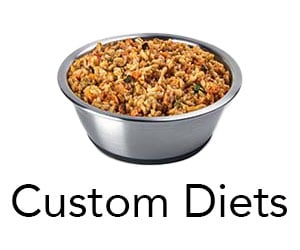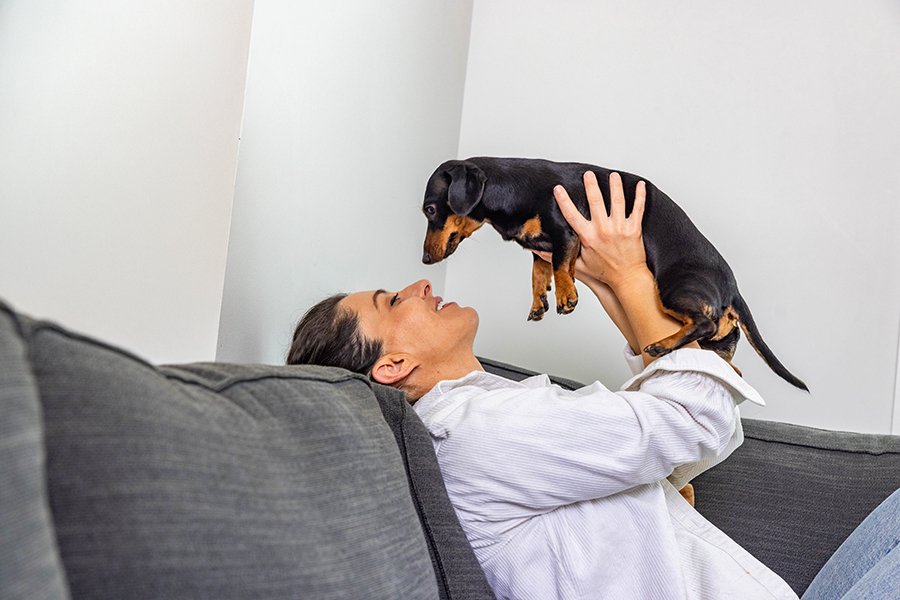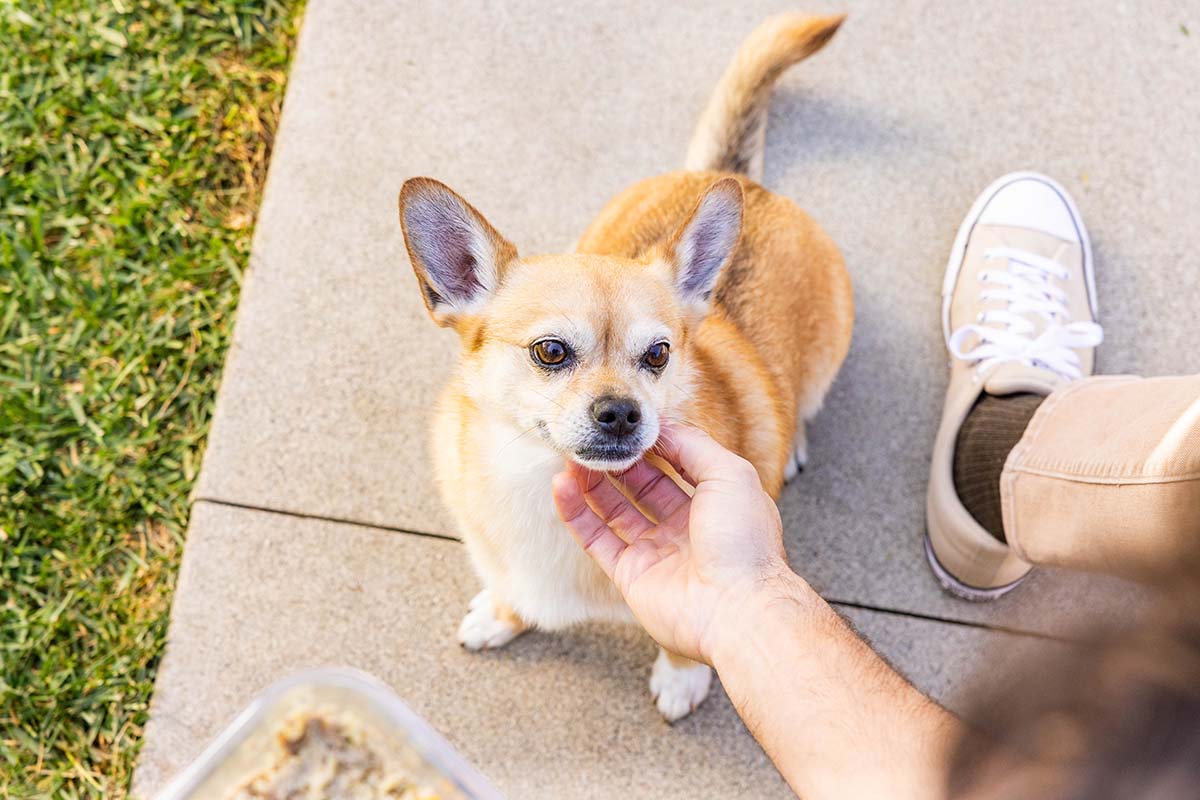How to Best Comfort a Dog With Pancreatitis
Pancreatitis in dogs can be very scary since it can come on fast, and the symptoms can be severe. Here's how to comfort a dog with pancreatitis.
Pancreatitis in dogs is a serious condition. While the medical definition of “inflammation of the pancreas” sounds mundane, it’s a potentially life-threatening condition and horribly painful.
There’s nothing more heartbreaking to a loving pet parent than to see their furry friend in distress. If your dog is diagnosed with something like pancreatitis, it can be even more unnerving if you don’t understand what you’re dealing with.
You may have heard about problems with the pancreas in humans, but you might not be aware that you’re best friend can have problems too. Pancreatitis in dogs can be very scary since it can come on fast, and the symptoms can be severe.
Let’s start with a quick overview of the pancreas and move on to the symptoms, risk factors, and preventive measures. Here’s what you need to know about this distressing illness and how you can take care of your furry friend when they need it most.
What Is the Pancreas and What Does It Do?

The pancreas is one of the most important organs in the body. It is located on the right side of the body next to the stomach.
It is responsible for producing the hormone insulin, which transports glucose from the bloodstream into the cells of the body. You might know that if that is not working properly, it can cause diabetes.
But the pancreas has another important function that involves helping your dog digest food. Aside from helping to regulate blood sugar levels, the pancreas produces several digestive enzymes and secretes them into the small intestines.
The pancreatic enzymes aid in breaking down sugars, fats, and starches. This makes the pancreas an important part of your dog’s digestive system.
What Is Canine Pancreatitis?
Pancreatitis simply means inflammation of the pancreas. This can happen in any breed of dog and at any age. Moreover, there are two types of pancreatitis: acute pancreatitis and chronic pancreatitis.
Acute pancreatitis comes on suddenly and can be mild or severe. The mild form involves edema (swelling) of the organ, while severe pancreatitis involves bleeding from within or around the pancreas.
When the pancreas swells, that allows those digestive enzymes to spill out into the abdomen, where they can cause secondary damage to the liver, bile ducts, gall bladder, and small intestines.
Those dogs who recover from pancreatitis may continue to have recurring bouts of the disease throughout their lives. This is known as chronic pancreatitis.
Causes of Pancreatitis
Many veterinarians and veterinary technicians will tell you that they see dogs with pancreatitis every year at certain times. It is quite common to receive dogs in the emergency clinic during Thanksgiving because they have been given or have gotten ahold of high-fat human food, and it has caused their pancreas to swell.
The reason the pancreas swells is that those pancreatic enzymes have been activated too early in the digestive process. Normally, as the digestive enzymes pass through the pancreatic duct before being released into the small intestine, they are inactive.
Those enzymes become active once they reach the small intestine, and they begin the process of digestion. But sometimes, the enzymes can be activated prematurely and begin their digestive process in the pancreas itself.
That causes swelling in mild cases and, in more severe cases, bleeding since the pancreas itself is being digested. This can happen because they get ahold of table scraps that are not a normal part of your dog’s diet.
But that’s not the only cause. It’s also possible that the administration of certain drugs, namely corticosteroids, can cause pancreatitis. It’s also true, however, that the exact cause of pancreatitis is unknown since many cases seem to occur spontaneously.
Symptoms of Pancreatitis
There are a number of common signs of pancreatitis in dogs, including:
- Nausea and vomiting
- Fever
- Loss of appetite
- Diarrhea
- Lethargy
- Abdominal pain and swelling
Abdominal pain
Your dog can’t tell you its stomach hurts but might show discomfort by pacing. If your dog seems restless and doesn’t want to lie down, this is a sign something’s wrong.
Vomiting and diarrhea
If your dog has these common gastrointestinal symptoms, try to discover what your dog ate recently. If you find your dog ingested fatty table scraps, seems lethargic, uncomfortable, and doesn’t want to eat, these could be signs of pancreatitis.
Fever, rapid heartbeat
Fever is a natural response to inflammation as it’s usually the body’s response to fighting infections. Pancreatitis can also affect the circulatory system, which in turn can speed up the heartbeat.
Dehydration
Vomiting and diarrhea can dehydrate your dog’s body. Some signs of dehydration include:
- sunken eyes
- sticky gums
- elevated heart rate
- increased panting
- loss of skin elasticity
If you can pinch your dog’s skin between the shoulder blades and it doesn’t immediately bounce back, that’s a sign of dehydration.
Jaundice
If your dog’s skin, gums, or the whites of the eyes look yellow, that’s a symptom of a chemical imbalance and requires prompt veterinarian attention to diagnose the cause.
Additionally, during an attack of pancreatitis, it’s common for dogs to take what’s called a ‘praying position’ where they put their rear end up in the air, and their front legs and heads are lower to the floor.
In severe cases, it’s possible they may suffer from acute shock, severe depression, and they can also die. Whether mild or severe, dog pancreatitis requires veterinary care.
How Will Your Veterinarian Treat Pancreatitis?

Veterinary care is a must when your dog has pancreatitis. The onset is often so sudden and severe that most dog owners will rush their best buddy right into the clinic. Once there, your DVM will begin the process of determining if it is actually pancreatitis before initiating care.
Diagnosis of Pancreatitis
Most cases of pancreatitis are diagnosed with blood work. Your veterinarian will likely perform blood tests to look for an elevation in white blood cells (this is prompted by inflammation) and/or certain pancreatic enzymes.
Innovations in testing in recent years can provide a rapid diagnosis. Specifically, the SPEC-CPL test, or the Specific Canine Pancreatic Lipase test, allows your veterinarian to quickly determine if pancreatitis is the cause of your dog’s symptoms. Lipase is one of the enzymes produced by the pancreas, and if it is elevated, that provides confirmation of the problem.
In some cases, your vet may also want to perform an ultrasound to visualize the inflammation of the pancreas or inflammation in the abdominal cavity. It is still possible, however, particularly in cases of chronic pancreatitis, that your vet will not be able to confirm the diagnosis with testing and may have to rely on clinical signs and medical history for a diagnosis.
Treatment for Pancreatitis
Once the diagnosis has been made, treatment can proceed. It mainly consists of allowing the pancreas to rest so that the body can heal itself. Vomiting dogs are not given any more food until the vomiting subsides, and they may also be given anti-nausea medication. These cases typically require fluid therapy to maintain hydration at appropriate levels.
If your dog is not vomiting, your vet will provide low-fat food that is highly digestible. They may also give your pooch pain medication to help control the pain. In more severe cases, anti-inflammatory drugs or anti-emetics (to control vomiting) may be required.
Additionally, if your veterinarian suspects an infection has set in, they may prescribe antibiotics followed by a course of probiotics to restore normal gut flora. Most cases of pancreatitis require hospitalization for a few or more days to get the symptoms under control. In life-threatening cases, your vet will utilize aggressive fluid therapy in combination with medications to counteract shock.
Once the treatment has worked its magic, your vet will likely send you home with a recommendation for a low-fat diet and perhaps supplements to help prevent any more flare-ups in the future. Choose cooked chicken breast vs. high-fat foods like bacon. Many dogs love sweet potatoes. Be sure you include foods with omega-3 fatty acids, as these have health benefits and properties that help maintain a normal inflammatory response.
How to Comfort a Dog with Pancreatitis

Your dog will need a period of time to fully recover from a bout of pancreatitis. Your vet will provide dietary recommendations to help keep him healthy, as well as medications and recommendations for exercise.
Usually, it’s best to follow a bland diet with pet food that consists mainly of lamb and white rice for some time. Even after your dog has fully recovered, it’s usually recommended to feed him low-fat dog food for the rest of his life. That helps reduce the risk of a recurrence.
It’s also usually best to offer your dog small, frequent meals during his recovery, and that’s not a bad model to follow as a rule from then on as well. Small meals are better than one or two bigger meals to help ensure your dog doesn’t experience another flare-up.
You’ll want to avoid fatty foods at all costs, and this includes his treats. It’s easy to forget about those when comforting a dog who has had this problem.
Of course, it’s vital to follow all of your vet’s guidelines regarding pain medication and anti-nausea medication. Be sure to use up all that your vet prescribes so that you won’t have a worse problem later on.
Finally, as part of comforting your dog, it’s important to provide plenty of cuddles, some short walks, and lots of rest. Just like with any human, recovery can take some time, so don’t push your pooch too hard before he’s ready.
Final Thoughts
If you’re like most loving pet parents, your dog is an important part of your family. Pancreatitis can be a frightening condition considering how important this organ is for your dog’s health. But, like with anything else, knowledge is power. Once you know what causes this problem and how it’s treated, you can begin to do what your dog needs to stay healthy.
Following your vet’s recommendations, feeding him small, frequent meals of high-quality, low-fat dog food, and giving him lots of love will help your dog recover and stay healthy. Pancreatitis is a scary problem to witness in your dog, but it is treatable with the proper care. Your love and comfort are a big part of that process.
For pancreatitis, our Nutrition Consultants typically recommend the Metabolic Support recipe (Rx required). Ask your vet if it may be appropriate for your pup.
This content is for informational use only and does not replace professional nutrition and/or medical advice, diagnosis, or treatment. It is not a substitute for and should not be relied upon for specific nutrition and/or medical recommendations. Please talk with your veterinarian about any questions or concerns.
Jensen, Kristine B., and Daniel L. Chan. 2014. “Nutritional Management of Acute Pancreatitis in Dogs and Cats.” Journal of Veterinary Emergency and Critical Care 24 (3): 240–50. https://doi.org/10.1111/vec.12180.








